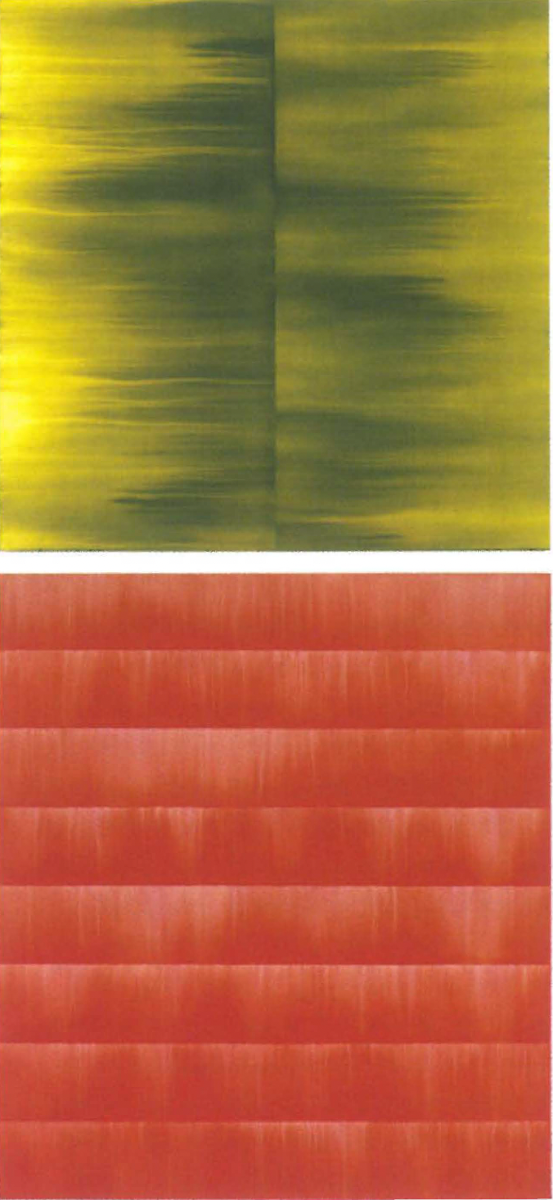
When familiar visual forms are re-presented to us by an artist the activity of looking can be forever transformed and our world re-configured through the experience. For many visitors to Jeremy Kirwan-Ward's exhibition at the Perth Galleries the mutable surface of the ocean and its mesmerising play of pattern and colour will now be framed by his vision. Those thick oily swells with their ever unfolding and reforming shapes and the extraordinary mix of reflected colour caught in their net have been recast for his audience. Like the Fred Williams bush we walk through and the Nolan outback we fly over the movement of the ocean is now fixed as a Kirwan-Ward experience.
In First Lago he captures with unerring skill the moment of glass-out when the winds change and the still ocean sparkles with phosphorescent dots of light and the slow rhythmical pulse of the sea on a grey day is brilliantly evoked in Large Three Way (Swell). Indeed each painting in the exhibition instantly equates to a remembered encounter with the ocean. For any coastal dweller there is a nodding sense of recall derived from hours spent in contemplative reverie at the beach, but Kirwan-Ward's new paintings attempt more than verisimilitude.
He is not only seeking the thrill of recognition, instead he is interested in the process of looking and how that experience might differ when viewing the surface of the ocean or the surface of a painting. The mode of presentation of his paintings, in multiple panels or divisions, suggests a shift or rupture that reinforces their separation from the real world. It is a device that highlights the surface of the canvas and reveals the processes that have created it. Each new pour of liquid acrylic paint is evident as it abuts others and the control of the fluid material into prescribed areas is the antithesis of the massive force of the moving, shifting ocean. It also provides a slippage through time that creates a cinematic sequence, which further transforms the continuous movement of the water into an artistic convention.
Six-fold fall records a gradual ripple of water moving forward or down, caught at the barriers then breaking over and continuing to flow. It is a mesmerising experience enhanced by the optical illusion of the flat surface that seems to bow and buckle as your eye runs back and forth across the canvas.
Another major work, Golden Two Way, is a Zen-like work that offers a slightly distorted mirror image of a late afternoon wash of light over water. Split down the middle compositionally Kirwan-Ward carefully duplicates the pouring of paint on either side to create similar but different forms that set up an endlessly absorbing conversation about nature, painting, time, chance and life. It is this secondary process of consciously finding and creating meaning that transforms the act of looking.
Day One and Day Two are also split down the middle but instead of a mirror image they contrast the vivid colour patterns of the daytime sea with the dense black rhythms it adopts at night. In place of the all-over compositions of earlier works and the multiple shifts and divisions of many works in the current show, the strong contrast between two elements suggests a dynamic shift and counterbalance that offers many possibilities for exploring the movement of water and the optical recording of light as it dances over its surface.
The best works in this show go far beyond the construction of an attractive surface and a display of technical brio. They force us to re-examine our patterns of reading and interpreting the world and provide new skills and new frameworks to continue that investigation.
Kirwan-Ward's has a well-established practice in Western Australia stretching back over thirty years but like many artists working outside the major centres of Melbourne and Sydney he is not as well known nationally as he deserves to be.












